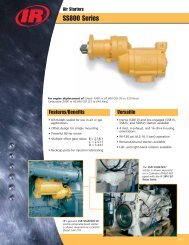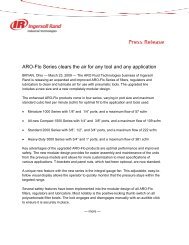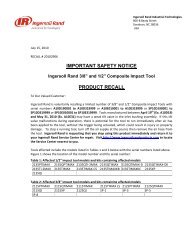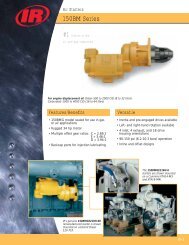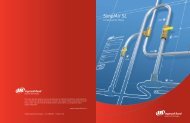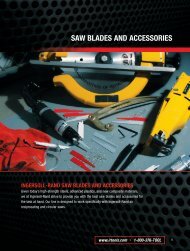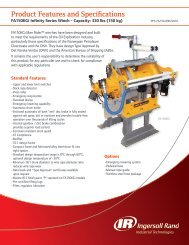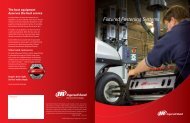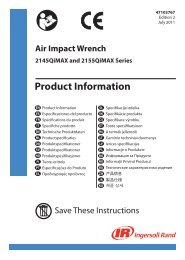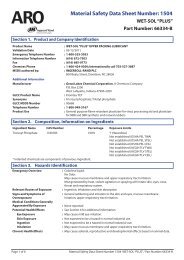Consulte - Ingersoll Rand
Consulte - Ingersoll Rand
Consulte - Ingersoll Rand
You also want an ePaper? Increase the reach of your titles
YUMPU automatically turns print PDFs into web optimized ePapers that Google loves.
Rail systems<br />
Systèmes de rails<br />
Laufschienensysteme<br />
Sistemas de rieles<br />
Sistemi di rotaie<br />
Typical system illustration*<br />
Illustration d'un système typique*<br />
Typisches System*<br />
Ilustración de sistema típico*<br />
Illustrazione sistema tipo*<br />
Air<br />
Supply<br />
Page 98<br />
Seite 98<br />
* <strong>Ingersoll</strong>-<strong>Rand</strong> rails systems are designed<br />
for perpendicular or parallel to header steel<br />
installations.<br />
* Les systèmes de rails <strong>Ingersoll</strong>-<strong>Rand</strong> peuvent être<br />
montés parallèlement ou perpenduculairement à la<br />
C<br />
structure porteuse.<br />
* Systeme von <strong>Ingersoll</strong>-<strong>Rand</strong> sind für die rechtwinklige<br />
oder parallele Montage an den Trägern der Deckenkonstruktion<br />
geeignet.<br />
* Los sistemas <strong>Ingersoll</strong>-<strong>Rand</strong> están diseñados para instalaciones perpendiculares o paralelas a las vigas de soporte.<br />
* Il sistema di rotaie <strong>Ingersoll</strong>-<strong>Rand</strong> può essere montato parallelamente e perpendicolarmente alle travi portanti.<br />
3<br />
Hanger<br />
Kits<br />
Page 97<br />
Seite 97<br />
5 4<br />
2<br />
End<br />
Trucks<br />
Page 96<br />
Seite 96<br />
Accessory<br />
B<br />
A<br />
End<br />
Stops<br />
Page 98<br />
Seite 98<br />
Accessory<br />
1<br />
Load<br />
Trolleys<br />
Page 95<br />
Seite 95<br />
WARNING: To correctly calculate the load capacity of each component described in the next pages, please apply<br />
the following rule of calculation: A+B+(C:2). A = Load to be moved, B = Balancer or hoist weight, C = Weight of<br />
the lower rails and trolleys divided by 2.<br />
ATTENTION: Pour calculer la capacité de charge requise pour chacun des élément présentés dans les pages<br />
suivantes, appliquer la règle de calcul A+B+(C:2). A = Charge à déplacer, B = poids de l'équilibreur ou du<br />
palan, C = poids des rails inférieurs et chariots divisé par 2.<br />
ACHTUNG: Für eine korrekte Kalkulation der max. Traglast der Bauteile auf den folgenden Seiten, verwenden<br />
Sie bitte folgende Berechnungsregel: A+B+(C:2). A = Bewegte Last (Werkstück), B = Gewicht Hebezeug,<br />
C = Gewicht der unteren Schienen inkl. Trolleys geteilt durch 2.<br />
ADVERTENCIA: para calcular correctamente la capacidad de carga de cada componente descrito en las<br />
siguientes páginas, por favor aplicar la siguiente regla de cálculo: A+B+(C:2). A = carga a mover, B = peso<br />
equilibrador ó polipasto, C = peso de los railes inferiores y carros dividido por 2.<br />
ATTENZIONE: Per calcolare correttamente il valore del carico pe rogni parte descritta nella pagina seguente,<br />
vogliate considerare la seguente formula A+B+(C:2). A = Carico da movimentare, B = peso del bilanciatore o<br />
del paranco, C = il peso più basso delle rail e carrelli diviso per 2.<br />
12<br />
95



